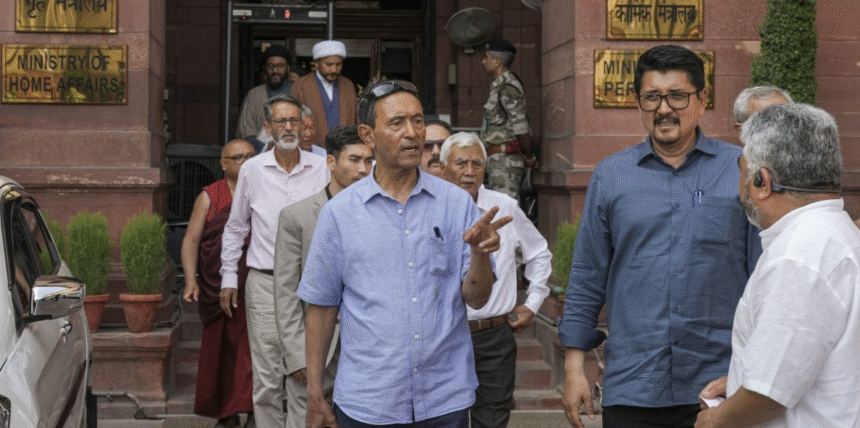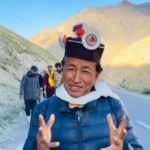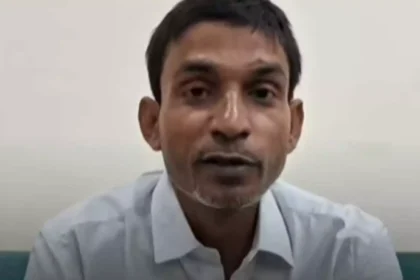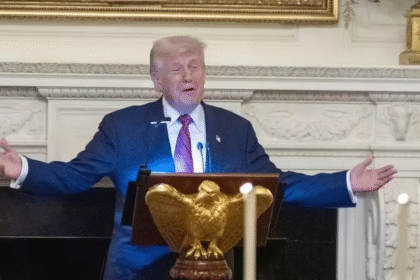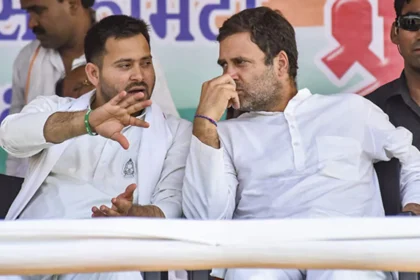Leh’s 25-Member Apex Body, Led by Chhewang and Wangchuk, Walks Away from BJP Over Stalled 6th Schedule Process
Leh’s Apex Body, comprising 25 members and led by Chhewang and Wangchuk, has walked away from its alliance with BJP due to stalled efforts on securing Sixth Schedule and autonomy for Ladakh.
Sonam Wangchuk Joins Apex Body Leh After Thupstan Chhewang’s Exit — A Turning Point in Ladakh’s Political Agitation
In a moment that could reshape the trajectory of Ladakh’s ongoing agitation for constitutional safeguards, celebrated innovator and environmentalist Sonam Wangchuk has been officially inducted into the Apex Body Leh (ABL), a civil society coalition spearheading the political negotiations with New Delhi. The announcement came merely a day after the surprise resignation of Thupstan Chhewang, the ABL’s chairperson and widely regarded as the tallest Buddhist political figure in the region.
This swift succession has opened up complex layers of political debate and public speculation—ranging from the direction of the autonomy movement to potential realignments before the upcoming Ladakh Autonomous Hill Development Council (LAHDC) elections. With Wangchuk’s elevation, a prominent face of environmental advocacy and non-electoral resistance now occupies centre stage in Ladakh’s high-stakes constitutional discourse.
A Sudden Exit with Long-Term Repercussions
Thupstan Chhewang, a former Member of Parliament and ex-BJP leader who broke ranks with the party in 2018 citing “false promises and empty rhetoric,” stunned observers on July 6 with a formal statement announcing his departure from the Apex Body. Citing “competing interests” and a refusal to engage in “individual agendas,” Chhewang’s decision sparked widespread concern over internal rifts within the Ladakhi civil society front.
Described by former ambassador and Ladakhi intellectual Phunchok Stobdan as a “towering and respected figure,” Chhewang’s resignation has been interpreted by several stakeholders as a “veiled warning” to Ladakh’s public and political class alike.
“It’s a symbolic signal,” said Stobdan. “It raises a big question mark on the cohesion, credibility, and direction of the movement.”
The Vacuum and the New Face
The induction of Sonam Wangchuk—best known internationally for his Ice Stupa project and a vocal campaigner for climate justice in the Himalayas—into the ABL’s High-Powered Committee (HPC) delegation has thus been perceived as both strategic and inevitable. The HPC, constituted by the Union Ministry of Home Affairs in 2023, includes officials from the Home Ministry and representatives from Kargil Democratic Alliance (KDA), the counterpart Muslim-majority civil coalition from Kargil.
In a statement released by the ABL on July 7, members cited Wangchuk’s “unwavering commitment” and “consistent advocacy of the people’s aspirations” as the rationale behind his elevation. With the Apex Body and KDA continuing to demand statehood, Sixth Schedule status, a separate public service commission, and two parliamentary seats, the inclusion of a figure like Wangchuk is being interpreted as an attempt to regain moral high ground and national attention.
The Shadow of Discontent and Split Loyalties
Behind the symbolism, however, lie tensions that are harder to dismiss. Political observers noted that Chhewang’s abrupt resignation comes against the backdrop of the Union Home Ministry’s refusal to concede any of the four-point demands raised jointly by the ABL-KDA coalition. Despite high-profile meetings and continued public outreach, no breakthrough has materialised, leading many to believe that frustration is mounting within Ladakhi leadership circles.
Simultaneously, questions have arisen about potential electoral motives. With LAHDC elections due in September–October 2025, some commentators—like Stobdan—have warned of factional strife and electoral ambitions being disguised under the rhetoric of civil agitation.
In a Facebook post that went viral across Ladakh and Delhi’s policy circles, Stobdan raised critical concerns:
“Are the youth of Ladakh being emotionally exploited with lofty slogans and alarmist narratives while certain individuals quietly prepare for the coming LAHDC elections? Is the ‘movement’ truly about the environment and constitutional safeguards—or is it a smokescreen for personal electoral gain?”
These remarks have found resonance among political analysts who have tracked similar agitations across Jammu and Kashmir post-Article 370 abrogation.
A Leadership Shift in Ladakh: Apex Body’s Balancing Act and Wangchuk’s Rise Amid Political Realignments
The Apex Body Leh’s decision to induct Sonam Wangchuk into its High-Powered Committee (HPC) delegation came amid a turbulent 48 hours that saw the resignation of Thupstan Chhewang, temporary withdrawal of senior Congress leader Nawang Rigzin Jora, and intensifying questions over Ladakh’s political unity. Behind the optics of this rapid transition is a civil society coalition attempting to recalibrate its leadership and negotiating leverage ahead of both critical talks with the Union government and the upcoming LAHDC (Leh Autonomous Hill Development Council) elections.
Internal Tensions and External Pressures
In the aftermath of Chhewang’s resignation, the ABL issued an urgent internal communication and convened a meeting on July 7 to assess its leadership structure. In an official statement, the body claimed that its members had visited Chhewang at his residence and “earnestly appealed to him to withdraw his resignation.” The statement reaffirmed their “unwavering support” and referred to Chhewang as the “sole leader capable of guiding the movement to its rightful destination.”
The efforts, however, failed to yield an immediate reversal of Chhewang’s decision. He assured members that he would “reflect on the matter” and respond in due time—maintaining a calculated silence that has been widely interpreted as a pause with political intent.
Simultaneously, another key figure, Nawang Rigzin Jora, also recused himself temporarily from the HPC and ABL’s subcommittee. In a written statement, Jora cited internal differences and recent developments but expressed continued ideological support:
“The Congress party shall continue to remain part of the ABL, support all genuine efforts toward achieving our avowed objectives—including the Sixth Schedule and statehood—and criticise any moves that undermine them.”
The ABL’s internal coordination committee later announced that Jora had reconsidered his decision and agreed to remain actively involved in the movement. Moreover, he reaffirmed his “unwavering support” for Thupstan Chhewang’s chairmanship, describing the latter’s leadership as “vital for the integrity of the struggle.”
This sequence of exits, appeals, and retractions has left political commentators speculating about hidden tensions and ideological fragmentation within the ABL’s leadership core, especially as it attempts to present a united front during formal negotiations.
Sonam Wangchuk’s Political Ascent
With Chhewang stepping back and Jora briefly disengaging, the timing of Sonam Wangchuk’s formal induction could not have been more consequential. Known globally for his environmental activism and innovation in sustainable development, Wangchuk has long refused formal association with electoral politics. Yet, over the last five years, he has emerged as the most visible and persuasive voice on climate justice, ecological fragility, and democratic rights in Ladakh.
Wangchuk’s repeated hunger strikes in 2023 and 2024, including one staged in sub-zero temperatures, received national media coverage and significantly raised the visibility of Ladakh’s constitutional demands. His public messaging—largely disseminated through digital campaigns and YouTube broadcasts—has been marked by a tone of civic restraint and Gandhian moral authority.
However, his growing influence has also led to political speculation. His endorsement of the new 15-year domicile policy rolled out by the Centre last month—calling it a “low-hanging fruit”—was seen by some as pragmatic and by others as tactically timed. Critics within Ladakh’s civil society have argued that the hunger strikes, online campaigns, and appeals to save glaciers and democracy may now be pivoting toward electoral or organisational power.
While Wangchuk continues to state that he has no intention of entering party politics, his entry into the Apex Body’s decision-making core—a first since the body’s formation—effectively places him at the centre of a deeply polarised and rapidly evolving political terrain.
The Centre’s Reluctance and Growing Agitation
Meanwhile, the Union Home Ministry has shown no signs of flexibility on the four core demands jointly presented by the ABL and Kargil Democratic Alliance (KDA). These include:
- Statehood for Ladakh
- Inclusion under the Sixth Schedule of the Constitution
- A separate Public Service Commission for Ladakh
- Two parliamentary seats—one each for Leh and Kargil
Despite multiple meetings between HPC representatives and ministry officials since 2023, no formal assurances or concrete timelines have been offered. This lack of progress is increasingly seen as the central reason behind growing frustrations within Ladakh’s civil leadership.
“The lack of movement from New Delhi, coupled with factional discontent, is putting enormous pressure on the leadership,” said political analyst Zafar Choudhary, editor of The Dispatch. “Chhewang’s exit, even if temporary, is a signal that the old guard may be disillusioned with the negotiation format.”
What Lies Ahead
With LAHDC elections around the corner and civil society under pressure to remain united, the ABL is treading a fine line. It must balance public expectations for transparency, coherence in its demands, and protection of Ladakh’s fragile ecosystem, while also ensuring that internal disagreements do not weaken the constitutional struggle.
Sonam Wangchuk’s role will be closely scrutinised in the weeks to come—not only for his ability to represent a younger, idealistic faction of Ladakhi society but also for how effectively he can mediate between conflicting agendas, including electoral aspirations and civil resistance.
BJP’s Electoral Calculus, Kargil’s Strategic Stand, and Wangchuk’s Rise Amid Ladakh’s Leadership Crisis
As the Apex Body Leh (ABL) tries to restore its equilibrium after Thupstan Chhewang’s surprise resignation and amid the symbolic elevation of Sonam Wangchuk, the Bharatiya Janata Party (BJP)—once considered a dominant force in Ladakhi politics—is quietly recalibrating its strategy ahead of the Leh Autonomous Hill Development Council (LAHDC) elections due in September–October.
This backdrop of civil society turmoil, electoral recalibration, and growing grassroots impatience is likely to shape the next phase of Ladakh’s political confrontation with New Delhi over autonomy and identity.
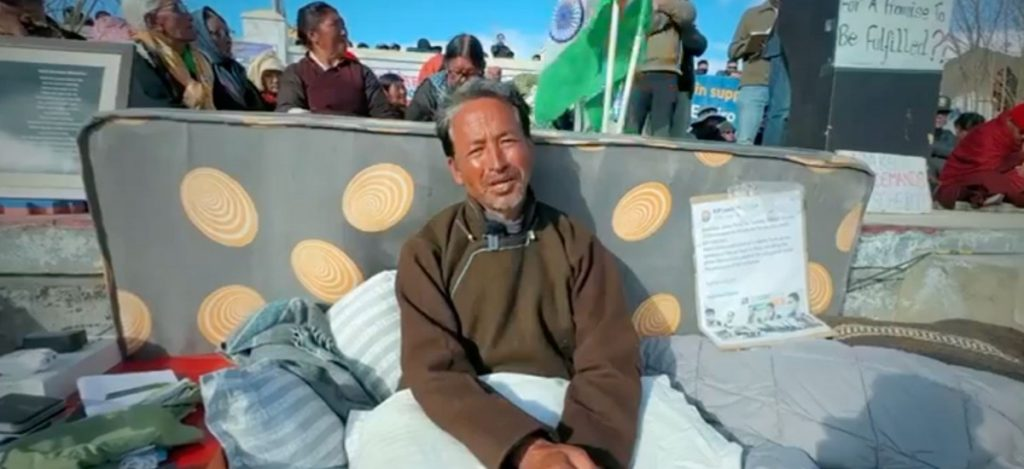
BJP’s Electoral Strategy: Caution Over Confrontation
Since Ladakh’s separation from Jammu and Kashmir in August 2019, the BJP has sought to portray itself as the architect of the Union Territory’s independent administrative identity. However, the 2024 Lok Sabha election loss in Ladakh—a stronghold it once counted on—has dented that narrative.
The ABL-KDA’s growing influence, amplified by Wangchuk’s civic campaigns and persistent demands for Sixth Schedule status, statehood, and local recruitment safeguards, has cornered the BJP on two fronts:
- Policy stagnation on constitutional issues that once garnered local support.
- Loss of narrative control in both Leh and Kargil to popular, non-party figures like Wangchuk.
Party insiders have indicated that the BJP is adopting a low-profile posture for now. Instead of taking overt positions on the ABL-KDA demands, the party has begun focusing on development messaging, infrastructure rollouts, and outreach to religious and youth organisations in a bid to retain electoral relevance.
A senior BJP functionary in Leh, speaking anonymously, noted:
“We are aware that any misstep or aggressive response to the civil society leadership could alienate the Buddhist youth. The Wangchuk factor has transformed the space. So we are relying on outreach rather than confrontation.”
Yet the silence of the BJP on Chhewang’s exit and the muted response to Wangchuk’s rise are being interpreted by political observers as signs of nervous recalibration rather than strategy.
Kargil Democratic Alliance (KDA): Holding the Alliance
While Leh navigates its internal power shuffle, Kargil Democratic Alliance (KDA)—the counterpart civil society body representing the Shia Muslim-majority Kargil district—has emerged as a stabilising partner in the joint constitutional movement.
Formed after Article 370’s abrogation, the KDA has consistently matched ABL in its articulation of the four-point demands. The alliance, despite ideological differences and demographic variations between Leh and Kargil, has stood as a rare example of Buddhist-Muslim civil unity in the region.
However, Chhewang’s departure has raised concerns within KDA over the stability of this coalition. According to KDA insiders, continued confusion or leadership vacuum in ABL could strain the joint front, especially during negotiations with the Home Ministry’s High-Powered Committee (HPC).
Dr. Mohammad Jaffer, a Kargil-based academic and commentator, noted:
“The strength of the ABL-KDA alliance lies in its ability to present a unified, interfaith, cross-district voice. That is what gave it legitimacy in the eyes of both the local people and Delhi. If the leadership in Leh begins to fragment, the Centre may exploit that to stall decisions further.”
For now, KDA has not issued any dissenting statements, and sources suggest it has informally welcomed Wangchuk’s induction as “a positive symbol” of continuity.
Wangchuk’s Potential Legacy: From Civil Resistance to Political Stewardship
With his induction into the ABL’s core committee, Sonam Wangchuk has now moved beyond symbolic protest to an institutional political role—without formally aligning with any party. This transition places him in a delicate yet powerful position: he is both an outsider to conventional politics and now a gatekeeper within Ladakh’s civil society power structure.
His history of non-violent resistance, public transparency, and grassroots mobilisation gives him an advantage in terms of public trust. His environmental activism, especially around glacier protection, local farming, and the fragile Himalayan ecosystem, gives him credibility on sustainable development—a key concern among Ladakh’s youth and rural voters.
However, Wangchuk’s formal association with ABL raises new questions:
- Can he balance his non-partisan image with the high-pitched political bargaining ahead?
- Will his entry encourage younger leaders or create new rivalries within ABL factions?
- How will Delhi respond to a movement increasingly personified by a global face of Himalayan activism?
While Wangchuk has publicly distanced himself from electoral ambitions, critics like Phunchok Stobdan and Zafar Choudhary have suggested that even civic activism can become politicised during moments of leadership transition.
Stobdan remarked:
“The problem is not Wangchuk himself. It is how others might rally around him and use his symbolic power for electoral goals. The theatre of resistance, as I call it, can easily morph into the theatre of elections.”
Delhi’s Delayed Response: Calculated or Risky?
From New Delhi’s perspective, the continued delay in accepting—or even debating—the four-point Ladakhi agenda has so far worked as a containment strategy. By offering occasional consultations and creating bureaucratic committees like the HPC, the Union government has managed to stall direct concessions while avoiding confrontation.
Yet the entry of Sonam Wangchuk into the leadership core, combined with persistent regional unity between ABL and KDA, may now alter that balance.
Ladakh’s civil society is no longer operating in silos or issuing symbolic statements. With Wangchuk on board, the next public mobilisation—if announced—will likely command national and international attention. Already, there are rumours of a third hunger strike being planned if the Home Ministry does not initiate concrete dialogue by August 2025.
The Centre may soon have to decide whether continued silence is a viable strategy or if a formal negotiation table with timelines and legal assurances is now inevitable.
Electoral Crossroads and the Strategic Future of Ladakh’s Civil Movement
As the Ladakh political landscape continues to shift under the weight of internal transitions, national indifference, and civil unrest, all eyes are now on the upcoming Leh Autonomous Hill Development Council (LAHDC) elections, scheduled for September–October 2025. These elections—ordinarily a routine exercise in local governance—now represent a litmus test for the credibility, unity, and endurance of the movement demanding constitutional guarantees for Ladakh.
This pivotal political moment could determine whether the region’s long struggle for autonomy is steered by principled civil actors, co-opted by electoral parties, or slowly diluted through fatigue and internal divergence.
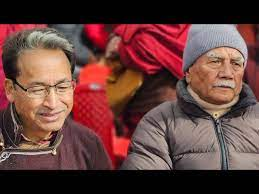
Thupstan Chhewang’s Strategic Silence: End or Evolution?
At the center of this moment remains Thupstan Chhewang—the soft-spoken but towering Buddhist political figure whose resignation from the Apex Body Leh (ABL) has unsettled even his critics. For two decades, Chhewang has defined the public face of Ladakh’s political aspirations, from his early years in Parliament to his eventual split from the BJP in 2018 over “unkept promises.”
His decision to quit the ABL came just as it was gearing up for another round of engagement with the Centre through the High-Powered Committee (HPC). Citing “individual agendas” and “competing interests”, Chhewang’s statement is being read in multiple ways:
- As a rejection of politicisation of a civil movement.
- As a warning against electoral opportunism by emerging local players.
- Or as a temporary withdrawal intended to shake up internal complacency and prompt reflection.
ABL members visited Chhewang after his resignation, urging him to reconsider. His response—“I will reflect on the matter and speak at an appropriate time”—left the door open for a possible return, but also hinted at disappointment with the internal state of affairs. Political observers see this as either a retirement from public life or a tactical move to test the strength of the organisation in his absence.
Either way, his silence has cast a long shadow on the immediate future of Ladakh’s civil unity.
LAHDC Elections: Movement vs Machinery
The Leh Autonomous Hill Development Council (LAHDC) governs key development and administrative functions in the Leh district. While its constitutional authority is limited, its symbolic power is enormous—particularly when movements such as the ABL’s are trying to claim legitimacy over Ladakh’s voice.
As the elections approach, three broad forces are positioning themselves:
- The Apex Body Leh (ABL), now fronted by Sonam Wangchuk and other civil society actors, is attempting to retain a moral high ground, hoping to push the BJP and Congress into supporting its four-point agenda as part of their electoral manifestos.
- The Bharatiya Janata Party (BJP) is in recovery mode, after its 2024 Lok Sabha defeat in Ladakh. It is quietly engaging Buddhist religious institutions and key youth groups, while also showcasing development projects initiated post-2019.
- Congress and smaller regional actors, including independents, are exploring ways to leverage the resentment against Delhi’s inaction, but without clear leadership. Some are even reportedly approaching civil society leaders for strategic alignments.
However, the biggest question remains: Will the ABL field or support candidates in the LAHDC polls?
So far, the ABL has not declared any electoral intent, but insiders suggest that if its four-point demands continue to be ignored by the Centre, it may formally enter the electoral arena—not as a party, but possibly through an independent civic platform.
This presents risks. While electoral participation might amplify ABL’s influence, it could also compromise its non-partisan appeal, especially for figures like Wangchuk, who have built credibility on the back of principled distance from vote-bank politics.
Delhi’s Next Move: Contain, Co-opt, or Concede?
The Centre’s strategy so far has revolved around delaying tactics, bureaucratic committees, and selective engagement. Despite repeated meetings between the Home Ministry and the ABL-KDA delegation, there has been no movement on the demands for:
- Statehood for Ladakh
- Sixth Schedule inclusion
- Public Service Commission for local recruitment
- Two parliamentary seats
With elections approaching, Delhi faces several options:
- Containment: Continue to engage selectively, offer minor administrative concessions (such as the domicile clause), and bet on electoral politics weakening the civil movement.
- Co-option: Reach out to individual leaders—especially those with electoral ambitions—and integrate them into a centralised narrative of “development-led governance.”
- Concession: Initiate a structured negotiation, possibly offering partial or phased implementation of the four-point demands, beginning with Sixth Schedule protections or special status for local recruitment.
However, all three paths carry risks. Containment could backfire if civil society mobilises larger public protests. Co-option could cause visible fragmentation and loss of credibility. And concessions—if poorly timed or insufficient—may only escalate demands rather than placate them.
The Wangchuk Factor: Symbolism, Strength, and Scrutiny
Now part of the ABL’s HPC delegation, Sonam Wangchuk stands at a crossroads. His inclusion was met with cautious optimism—his moral authority, media reach, and youth appeal make him an ideal ambassador for the constitutional movement.
But Wangchuk’s brand is now exposed to political crossfire.
He has been accused—implicitly by voices like Phunchok Stobdan—of using environmental and democratic language to mask political ambitions. His decision to praise the Centre’s 15-year domicile clause was seen by critics as selective endorsement aimed at maintaining influence.
He now walks a tightrope:
- If he remains too symbolic, he risks being seen as ineffective.
- If he becomes too politically involved, he risks losing the civil neutrality that has powered his legitimacy.
A Larger Federal Struggle in the Himalayas
At a broader level, Ladakh’s movement reflects India’s deeper federal fault lines. From Bodoland to Nagaland, from Jammu to Mizoram, regional movements rooted in ethnic identity, cultural preservation, and local governance continue to challenge the one-size-fits-all governance model.
Ladakh is unique in that its civil society is united across religious lines, and the struggle is being led not by parties or insurgents, but by engineers, monks, professors, and farmers. Its call for constitutional safeguards, not secession, makes it an even more compelling test case for democratic negotiation in a union of states.
The Road Ahead
As July 2025 draws to a close, Ladakh stands at a fragile yet potent crossroads.
- The ABL’s moral capital remains high, but it must avoid internal fissures.
- The Centre must move from bureaucratic engagements to political decisions.
- The electorate must distinguish between resistance and opportunism.
- And leaders like Wangchuk must define their long-term role: conscience keepers, political actors, or both.
If Ladakh’s constitutional struggle succeeds, it could redefine how India negotiates demands for autonomy—through peaceful agitation, interfaith unity, and civil leadership rooted in service.
If it fails, it will not be because of Delhi’s resistance alone, but because Ladakh’s leadership could not remain united, principled, and clear in its goals.
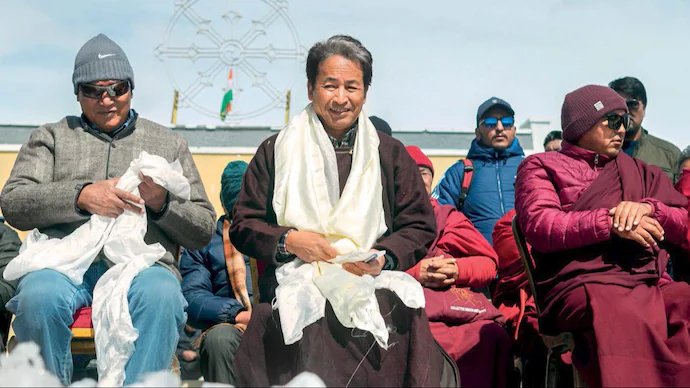
The Final Frontier – Ladakh’s Constitutional Struggle and the Shifting Tides of Himalayan Federalism
As the Ladakh movement enters a crucial phase, with the Apex Body Leh (ABL) reorganizing, electoral forces mobilizing, and Delhi maintaining calculated ambiguity, the question now turns to what comes next. What will define the fate of Ladakh’s four-point charter of demands? Will the region secure the autonomy it seeks, or be absorbed into the status quo through political fatigue and centralised control?
The future of the movement, and indeed of India’s federal structure in the strategically sensitive Himalayas, may now hinge on a convergence of three axes—civil society unity, voter mobilisation, and Delhi’s political calculus.
The Struggle for Cohesion – Can the ABL Stay United?
Despite the Apex Body Leh (ABL) and the Kargil Democratic Alliance (KDA) forging a rare interfaith and interregional alliance, internal strains have begun to show. The resignation of Thupstan Chhewang, and the recusal of senior Congress leader Nawang Rigzin Jora, have highlighted competing visions, strategic disagreements, and electoral anxiety within the movement.
Sources inside the ABL describe two broad camps:
- The civic integrity faction, represented by figures like Sonam Wangchuk and educationists, wants to maintain the non-partisan, moral force of the movement, relying on grassroots mobilisation, hunger strikes, public engagement, and ethical protest.
- The electoral pragmatist faction, which includes aspiring candidates and political actors, believes that only participation in institutional politics—particularly in the LAHDC elections—can achieve results, especially when central engagement has stalled.
The risk is fragmentation. If civil society is seen as sacrificing principle for power, the movement could lose the public trust that currently sustains it.
The movement’s legitimacy depends not just on what it demands, but how it behaves in the public eye—especially in a region where identity, faith, and dignity are central to civic participation.
The Voter and the Ballot – LAHDC 2025 as a Mandate
The Ladakh Autonomous Hill Development Council (Leh) elections, likely in September–October 2025, are now being billed as a referendum on the four-point agenda:
- Statehood for Ladakh
- Sixth Schedule constitutional protections
- A dedicated Public Service Commission
- Two separate Parliamentary constituencies for Leh and Kargil
The BJP, wounded from its Lok Sabha 2024 defeat, has already begun rebuilding alliances with Buddhist religious institutions and floating development-centric narratives, showcasing road connectivity, tourism schemes, and defense-linked projects as proof of “progress post-Article 370 abrogation.”
However, the electorate in Ladakh, particularly the younger generation, appears unmoved by development without representation. Wangchuk’s YouTube outreach, environmental hunger strikes, and symbolic sit-ins have deeply resonated with youth in both Leh and Kargil, who see the demand for constitutional safeguards as a fight for identity, not just jobs or infrastructure.
If the ABL or its supported candidates sweep the council polls, it will send a clear message to Delhi: Ladakh’s demands are not isolated to activists or monks, but are a mass political mandate.
If the BJP regains control, the movement risks being portrayed as fringe, and Delhi will likely cite the LAHDC results as popular approval of the status quo.
The Centre’s Response – Delay, Dialogue or Decision?
The Union Ministry of Home Affairs (MHA) has shown a pattern of non-committal engagement with Ladakh’s demands since 2020. Several rounds of dialogue with the High-Powered Committee (HPC) have yielded no concrete timeline, white paper, or roadmap.
The only significant development has been the domicile clause, establishing a 15-year residency requirement for local jobs and land purchases. While welcomed as a “low-hanging fruit” by Wangchuk and others, it falls far short of Sixth Schedule protection.
Three potential scenarios now face Delhi:
- Pre-election De-escalation: Minor concessions—perhaps around PSC recruitment, education quotas, or land protection—may be offered to divide the movement and deflate momentum.
- Post-election Pushback: If the ABL gains power in LAHDC, the Centre could tighten administrative control, using bureaucratic tools to dilute local influence and delay constitutional reforms further.
- Strategic Compromise: With mounting national and international scrutiny—especially on the China border—Delhi might consider limited Sixth Schedule protections, while retaining UT status, to preserve strategic flexibility and calm dissent.
Delhi’s decision may hinge not just on Ladakh, but on how it calculates the risks of setting a precedent for other autonomous demands across India—from Gorkhaland to Bodoland to Tripura.
The India-China Dimension: A Geopolitical Shadow
The Ladakh movement is not merely domestic in character. It is playing out in one of the world’s most geopolitically volatile zones—India’s border with China, including disputed areas like Demchok and Pangong Tso.
Observers argue that diluting local governance structures, weakening civil legitimacy, and ignoring ethnic aspirations in Ladakh undermines India’s national security posture. A disaffected populace—disempowered and disillusioned—cannot be India’s frontline strength in the Himalayas.
Even within the Indian security establishment, there is growing awareness that stability in Ladakh cannot be maintained by military deployment alone, but must be underpinned by political legitimacy and local trust.
The Battle for Ladakh’s Soul: Identity, Ecology, and Federalism
The Ladakhi movement is now emblematic of a deeper Indian dilemma: Can a centralised republic accommodate the plural, cultural, ecological, and spiritual identities of its peripheries?
The stakes go far beyond development statistics:
- This is about protecting fragile high-altitude ecosystems, under threat from unchecked military construction and climate change.
- This is about cultural preservation, especially of Tibetan Buddhist practices and Islamic traditions in a region with millennia-old religious coexistence.
- And this is about federalism itself—about whether Delhi can co-govern rather than control.
If Ladakh is allowed to define its future through peaceful democratic means, India will have affirmed the promise of its Constitution in the most sensitive part of its territory.
If not, the region may see rising frustration, mass boycotts, international attention, and a moral crisis for Indian democracy in its 75th year as a republic.
Conclusion: The Final Word is Yet to Be Written
The ABL’s next moves, the public’s verdict in LAHDC, and Delhi’s political posture in the weeks ahead will determine whether Ladakh’s historic movement ends in constitutional victory, co-opted compromise, or civil burnout.
The hope remains that this Himalayan struggle—led not by militancy or extremism but by monks, engineers, teachers, and students—will carve a new path for democratic negotiation in India.
A path where unity is not punished, where identity is not diluted, and where dignity and development can walk together.
Also Read : YouTuber Jyoti Malhotra’s Judicial Custody Extended by 14 Days in Espionage Case Involving Classified Leaks


